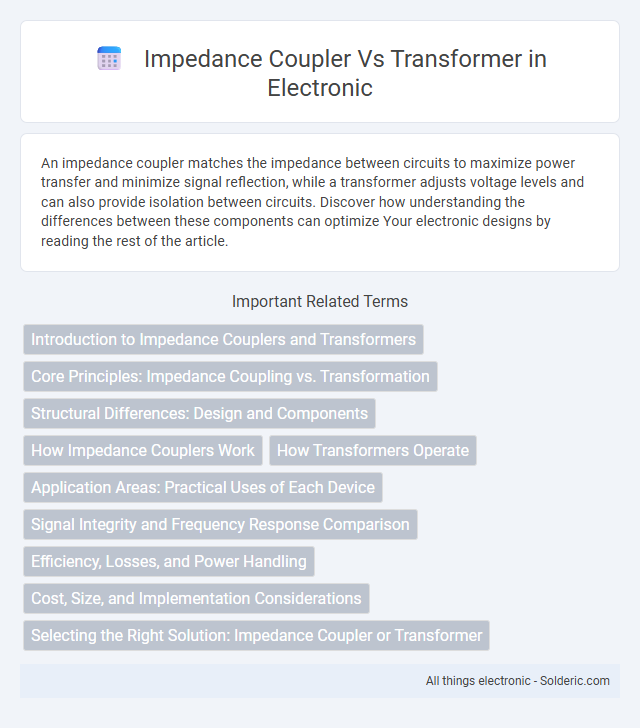An impedance coupler matches the impedance between circuits to maximize power transfer and minimize signal reflection, while a transformer adjusts voltage levels and can also provide isolation between circuits. Discover how understanding the differences between these components can optimize Your electronic designs by reading the rest of the article.
Comparison Table
| Feature | Impedance Coupler | Transformer |
|---|---|---|
| Function | Matches impedance between circuits for signal transfer | Transfers electrical energy between circuits via magnetic induction |
| Frequency Range | Broadband, suitable for RF and audio frequencies | Limited by core material, typically low to mid frequencies |
| Size | Compact and lightweight | Generally larger due to magnetic core |
| Energy Efficiency | Moderate, losses depend on circuit design | High efficiency with minimal losses |
| Signal Distortion | Low distortion when properly designed | Very low distortion, preserves signal integrity |
| Isolation | No galvanic isolation | Provides galvanic isolation between circuits |
| Typical Applications | RF matching networks, antenna systems | Power supplies, audio systems, impedance matching |
| Cost | Generally lower cost | Typically higher due to materials and complexity |
Introduction to Impedance Couplers and Transformers
Impedance couplers and transformers serve as essential components in electrical and electronic circuits to match impedances and ensure efficient power transfer. An impedance coupler typically uses active or passive circuitry to adjust signal levels without significant power loss, optimizing frequency response and minimizing distortion. Transformers, on the other hand, rely on electromagnetic induction with coils and magnetic cores to convert voltages and currents, providing galvanic isolation and handling higher power levels with intrinsic impedance transformation based on turn ratios.
Core Principles: Impedance Coupling vs. Transformation
Impedance couplers operate by matching the load impedance to the source impedance through resistive or reactive components, optimizing power transfer and minimizing signal reflection. Transformers achieve impedance transformation via electromagnetic induction between primary and secondary windings, allowing voltage and current levels to be adjusted while maintaining power conservation. Core principles differentiate by impedance couplers relying on direct impedance matching networks, whereas transformers use magnetic coupling for efficient energy transfer and impedance scaling.
Structural Differences: Design and Components
Impedance couplers primarily use passive components such as resistors, capacitors, and inductors arranged in networks to match impedance between circuits without electromagnetic coupling. Transformers rely on magnetic cores and coils wound around them to transfer energy through electromagnetic induction, inherently providing galvanic isolation. While couplers prioritize minimal signal loss with simple linear elements, transformers involve complex magnetic materials and winding configurations for voltage or current transformation.
How Impedance Couplers Work
Impedance couplers function by matching the impedance between two circuits to maximize power transfer and minimize signal reflection, using components such as resistors, inductors, and capacitors arranged in specific configurations. Unlike transformers, which rely on magnetic induction and coil windings to perform impedance matching, impedance couplers use passive electronic elements to achieve impedance transformation without the need for magnetic cores. This allows impedance couplers to effectively interface circuits operating at different impedance levels while maintaining signal integrity in RF and audio applications.
How Transformers Operate
Transformers operate by transferring electrical energy between circuits through magnetic induction, using coils of wire wrapped around a core. The primary coil creates a magnetic field when current passes through it, inducing voltage in the secondary coil and enabling efficient voltage transformation. Your choice between an impedance coupler and transformer depends on whether precise voltage conversion or simple impedance matching is required.
Application Areas: Practical Uses of Each Device
Impedance couplers are widely used in radio frequency (RF) circuits and antenna systems to match impedance, minimizing signal reflection and maximizing power transfer in communication devices, transmitters, and receivers. Transformers find practical applications in electrical power distribution, audio equipment, and impedance matching in low-frequency circuits, where voltage transformation and isolation between circuits are critical. Both devices enhance signal integrity but target different frequency ranges and functional requirements in electronic and power systems.
Signal Integrity and Frequency Response Comparison
Impedance couplers provide superior signal integrity by minimizing signal reflection and maintaining consistent impedance across a wider frequency range compared to transformers, which can introduce phase distortion and insertion loss at higher frequencies. Transformers, while effective at isolation and voltage level shifting, often exhibit limited frequency response due to core material properties and parasitic inductances that degrade high-frequency performance. The choice between impedance couplers and transformers impacts system bandwidth and signal fidelity, with impedance couplers generally favored in high-frequency applications requiring precise impedance matching and minimal signal degradation.
Efficiency, Losses, and Power Handling
Impedance couplers typically offer higher efficiency and lower losses compared to transformers due to their simpler design and minimal magnetic components, making them ideal for high-frequency applications. Transformers, while capable of handling higher power levels, often introduce core and copper losses that reduce overall efficiency, especially at HF and RF bands. Your choice between these two should consider the required power handling capacity and efficiency targets for the specific application.
Cost, Size, and Implementation Considerations
Impedance couplers generally offer a more cost-effective and compact solution compared to transformers, making them ideal for applications with strict size constraints. Transformers require careful design to avoid signal loss and electromagnetic interference, often resulting in bulkier components and higher manufacturing expenses. Your choice should consider the specific impedance matching needs and implementation complexity, balancing cost efficiency with performance requirements.
Selecting the Right Solution: Impedance Coupler or Transformer
Selecting the right solution between an impedance coupler and a transformer depends on the application's frequency range, power requirements, and signal integrity needs. Impedance couplers offer precise impedance matching in high-frequency circuits with minimal insertion loss, making them ideal for RF and microwave applications. Transformers provide galvanic isolation and voltage transformation, suitable for power transfer and audio frequency ranges, where electrical isolation is crucial.
impedance coupler vs transformer Infographic

 solderic.com
solderic.com